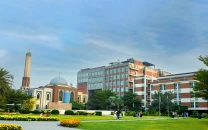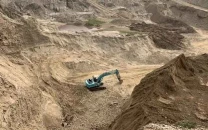The untapped potential of olive cultivation
Oil production can reduce import expenses

Olive cultivation and oil production is an area in Pakistan’s agro-based economy with untapped potential which can help reduce foreign exchange expenditure on imported edible oil, according to local farmers.
The fields of Punjab and its sunny winters make many regions suitable for olive cultivation, which requires a warm and temperate environment. The Pothohar region has a most suitable climate. Wild olives are found abundantly strewn across the Kallar Kahar, Khora, Mandial and Kunhati Bagh areas, as well as the Kufri villages.
Several farmers from Sten region said while speaking to The Express Tribune that the olive tree is a “hardy and evergreen tree” that can grow in all types of soil except in saline soil and in areas with stagnant water. Its roots do not extend deep underground, which makes it possible to be cultivated even in hilly areas.
According to a farmer, Malik Ameer Awan, cultivation of commercial olive varieties such as Ottobratica, Coratina, Frantoio, Leccino and Mirailo in the valley can help generate an annual income of about Rs6 billion. While olive plants usually begin to bear fruit in four to five years, each of them can be farmed for commercial production for about 20 years.
However, for a good yield, quality means such as modern irrigation systems, proper drainage and adequate fertilisers are required. Following the harvest, processing of the olive fruits is also essential since it naturally has a bitter taste. Olives are either fermented or washed with brine to remove its bitterness, after which it can be preserved either in its original state or as paste. For olive oil extraction it is essential to pick the fruits when they take a shade that is half green and half purple. A hydraulic press or a centrifugal machine is used for oil extraction.
The Agricultural Research Institute of Rainfed Areas has installed small machines in the Chakwal district to provide farmers with oil extraction facilities. A high-capacity processing plant that is equipped with facilities to extract 500kg of olive oil per hour has also been developed.
Farmers highlighted a number of ways to maximise profit through olive cultivation. This includes planting certain varieties of the plant such as Ottobratica, Coratina, Frantoio, Leccino, and Mirailo that are best for olive oil extraction and commercial production. These specific varieties already exist in the wild and can be transplanted or grafted. In addition, it is also essential to properly inspect the soil before the plantation of a new olive grove as this will reduce the costs of land preparation for farmers and increase income.
The modern bubbler and drip irrigation systems can help produce higher yield from smaller areas of land. Moreover, certain specifications such as acidity levels lower than 1% in the fruit and good aroma can sell the harvest at higher prices.
There exist more than 100 varieties of olives that are consumed in the form of pickles and oil. In addition to its uses in cooking, olive oil in itself is also beneficial for health issues such as heart diseases, insomnia and muscle weakness. It can be used for production of many kinds of commercial products and markets such as the growing local restaurant business.
Published in The Express Tribune, November 7th, 2022.



















COMMENTS
Comments are moderated and generally will be posted if they are on-topic and not abusive.
For more information, please see our Comments FAQ